

EC1784
Victoria L. Simonsen, University of Nebraska—Lincoln student, Ecosystem Monitoring and Assessment
Jacob E. Fleischmann, University of Nebraska—Lincoln student, Ecosystem Monitoring and Assessment
Doug E. Whisenhunt, USDA-NRCS
Jerry D. Volesky, Extension Range and Forage Specialist
Dirac Twidwell, Assistant Professor, Rangeland Ecology
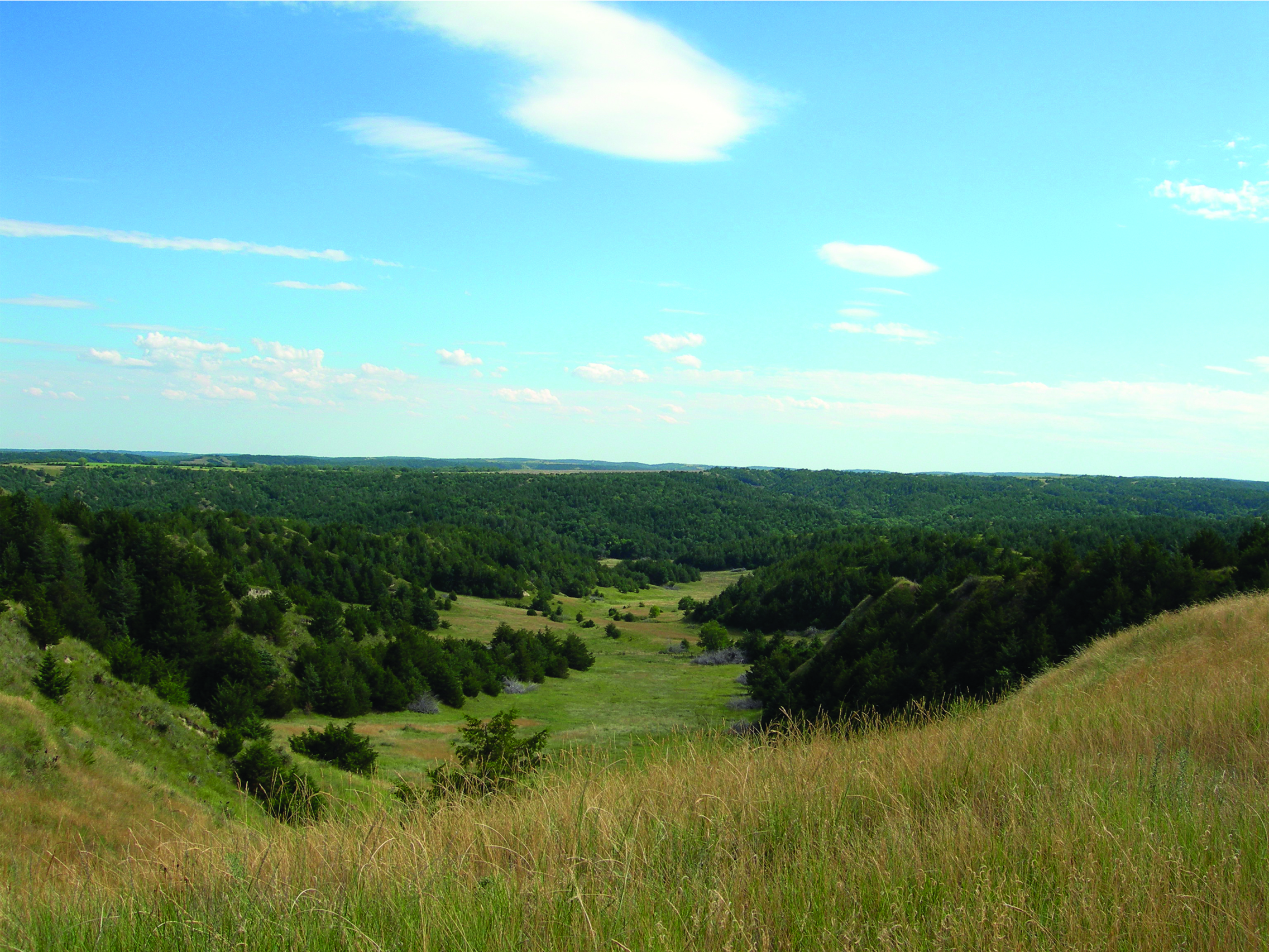

Figure 1. Eastern redcedar has already severely invaded several areas of Nebraska, but great potential exists to prevent cedar from having the major negative impacts on ecological and production values that have already occurred in the southern Great Plains. Note: This map indicates cedar density within all forestlands and may not be representative of actual cedar locations. (Photo and data courtesy of Nebraska Forest Service)
The prairies of the Great Plains are currently threatened by invasion of Eastern redcedar (Juniperus virginiana L.) (Twidwell et al. 2013a). This includes Nebraska where many areas are severely invaded (Figure 1). As redcedar encroaches and increases in canopy cover, species diversity that is endemic to grasslands collapses and production of herbaceous biomass (forage) underneath decreases, resulting in a loss of livestock carrying capacity (Smith and Stubbendieck 1990; Engle et al. 1987; Limb et al. 2010; Twidwell et al. 2013a). After complete conversion of grasslands to juniper woodland, enough herbaceous material is displaced that a 75 percent decrease in forage production has been consistently observed (Ortman et al. 1998; Fuhlendorf et al. 2008).
The economic consequences of this conversion to cattle producers can be significant. In southeast Nebraska tallgrass prairie, it typically takes 40 years for native grassland to convert to a closed canopy Eastern redcedar woodland where trees become so dense that nearly all grass is removed (Figure 2a). Earnings potential in such areas collapses during this timeline (Figure 2b). Yet, the more significant change occurs much earlier when Eastern redcedar populations begin to rapidly increase in size, abundance, and distribution. Data from tallgrass prairie experiments (Briggs et al. 2005; Limb et al. 2010) demonstrate that forage loss is relatively low during the first 15 years of juniper invasion (Figure 2a), which means that producers will not readily observe declines in carrying capacity during the early years of invasion (Figure 2b). From year 15 to year 30, however, juniper rapidly displaces herbaceous forage and has been associated with an 80 percent reduction in potential livestock returns (Fuhlendorf et al. 2008).
Given market prices listed for feeder cattle from the Chicago Mercantile Exchange group in August from 2009–2013, price per 100 lb weight ranged from $82.68 in 2009 to $122.70 in 2013. With a loss of 80 percent of cattle carrying capacity from year 15 to year 30 during the cedar invasion process, a producer running a herd of 50 feeder cattle averaging 500 pounds and getting a return of $30.68 in 2013 (Figure 2c) would have to reduce his or her herd by 40 animals to adjust to the lower carrying capacity. This would result in a return of $6,135 in 2013, which is $24,540 less than the producer would have received in the absence of juniper invasion.
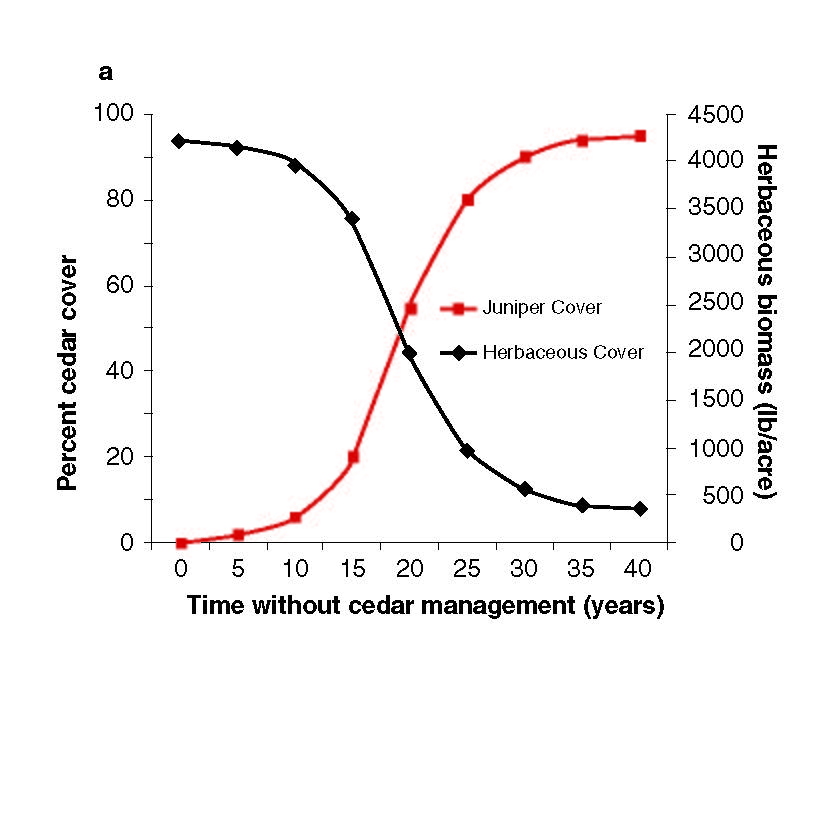
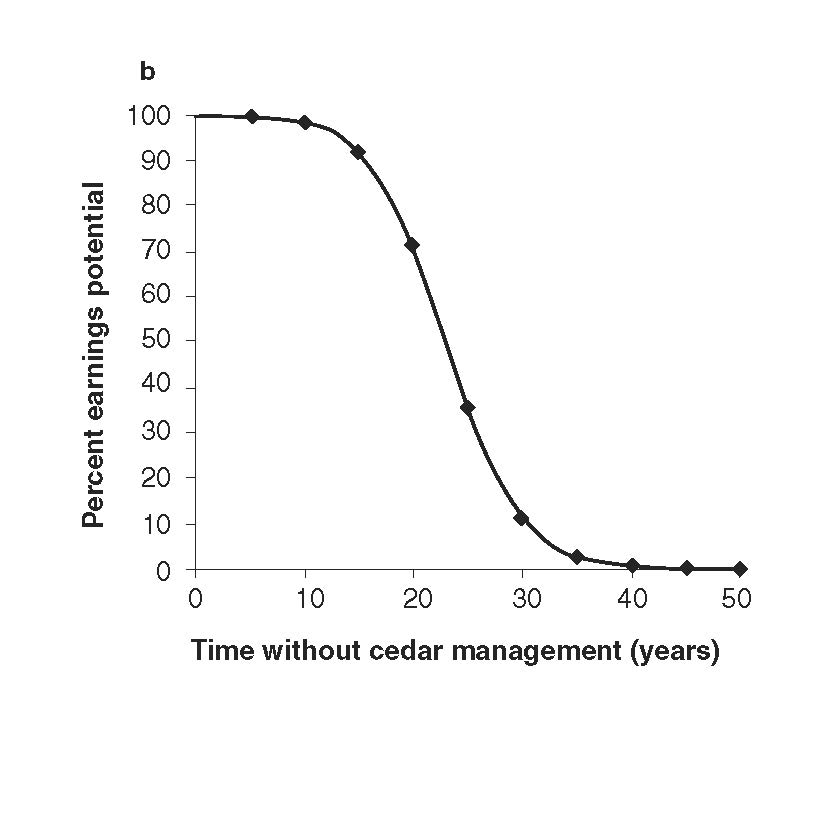
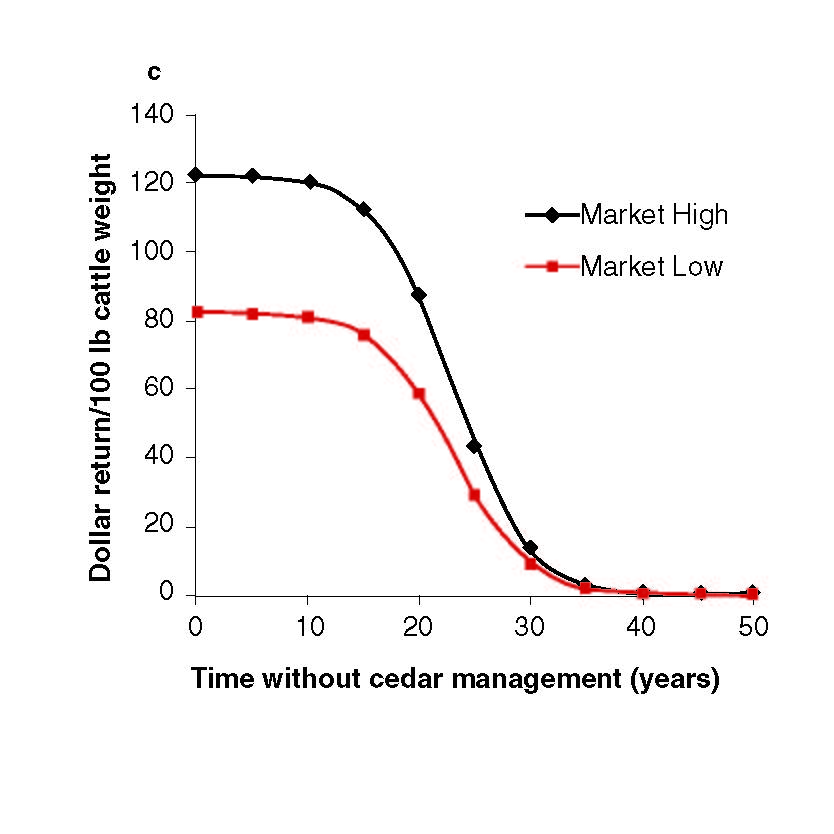
Figure 2. An example of the expected loss in forage production and economic return for a cattle producer in southeastern Nebraska as Eastern redcedar invasion progresses into native tallgrass prairie. Panel (a) shows the decrease in herbaceous biomass production as cedar canopy coverage increases. Panel (b) shows the decline in the earning potential of land as forage production decreases with increasing cedar cover. Panel (c) shows the predicted loss of dollar return per hundred pounds of cattle weight during the market high and low as a result of increasing cedar cover. These trends can be expected anywhere cedar invasion occurs. However, the rates depicted will differ as a consequence of how quickly cedar invades. For example, a producer in the Sandhills of Nebraska would experience a slower rate of change than a producer from southeastern Nebraska because cedar tree invasion occurs at a slower rate. Note: Data used in these figures have been derived from published information presented in Briggs et al. 2005, Fuhlendorf et al. 2008, Limb et al. 2010, and from market values from the Chicago Mercantile Exchange group.
Land managers have a key choice to make when considering the appropriate time to combat Eastern redcedar invasions. Should preventative management actions be implemented before the signals of juniper invasion emerge? Or, should reactive management approaches be used once juniper has become dominant and a major problem? For this analysis, we used cost-share data from the Natural Resources Conservation Service-Environmental Quality Incentives Program (NRCS-EQIP) to demonstrate the general tendency to react to Eastern redcedar invasions rather than preventing their establishment and spread.
We then discuss the limitations of using a reactionary approach as the foundation for managing Eastern redcedar invasions and use data on the amount of area cost-shared through NRCS-EQIP as an example of the challenges associated with restoring large areas that have been converted to juniper woodlands. We also discuss the advantages, as well as the limitations, for moving toward management that seeks to prevent juniper establishment and spread, rather than relying on a reactionary approach.
Between 2004 and 2013, $7,948,116 was spent by the NRCS on cost-sharing for cutting and mechanical removal techniques of Eastern redcedar, and $699,824 was used to implement prescribed burning techniques for cedar control (Table 1). However, cost-sharing for both techniques was implemented in areas with high levels of juniper invasion; thus nearly all the funds were used to react to juniper invasion (Doug Whisenhunt, personal communication).
Table 1. Summary of NRCS EQIP cost-share expenditures from 2004–2013 for the various proactive and reactive techniques that can be used to manage Eastern redcedar.
|
Techniques used for cedar control |
Management strategies |
Total number of acres implemented |
Total cost of implementation |
Average number of projects/year |
Average acres/project |
Average cost/acre |
|
|
Proactive |
Reactive |
||||||
|
Cutting/mechanical removal |
X |
138,869 |
$7,948,116.09 |
285 |
51.80 |
$53.81 |
|
|
Prescribed burning |
X* |
X* |
96,328 |
$699,824.41 |
47 |
197.21 |
$7.34 |
|
Herbicide application |
X |
Minimal to none |
Minimal to none |
Minimal to none |
Minimal to none |
Minimal to none |
|
|
Haying |
X |
Minimal to none |
Minimal to none |
Minimal to none |
Minimal to none |
Minimal to none |
|
|
High density goat grazing |
X |
Minimal to none |
Minimal to none |
Minimal to none |
Minimal to none |
Minimal to none |
|
Note: The NRCS-EQIP cost-share data in this table is from the NRCS Nebraska Report of Brush Management Applied-Practice Summary from 2004–2013 and the NRCS Nebraska Report of Prescribed Burning Applied-Practice Summary 2004–2013.
*EQIP cost-share use for prescribed burning has almost exclusively been for reactive management. (Doug Whisenhunt, personal communication)
Mechanically cutting and removing cedars is one of the most common responses to cedar invasions, but there are practical and economical limitations that can reduce its effectiveness (Figures 3 and 4). Physical removal is very effective at thinning an area where cedar trees have established because cedars do not resprout (Engle and Kulbeth 1992; Owensby et al. 1973). For trees less than 3 feet tall, hand shears may be sufficient for removal, but this approach needs to be a consistent part of landowner management plans to stay ahead of invasions on large landscapes.
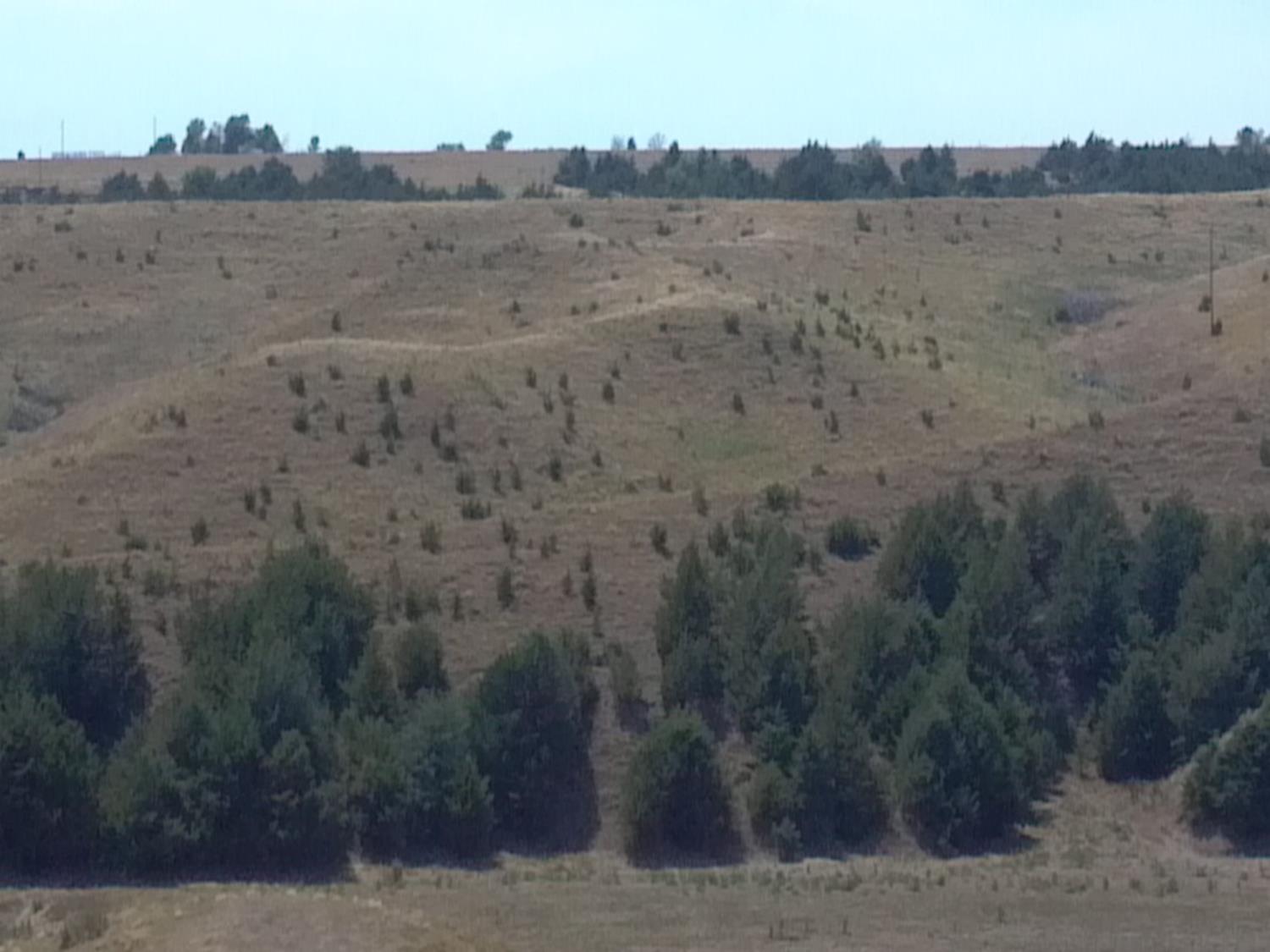
As trees grow taller and increase in size, physical removal is still effective, but larger equipment is needed. This type of equipment is typically more expensive than other management options (Twidwell et al. 2013b), and it is often unable to reach areas with difficult access and/or steep slopes. Thus, mechanical removal may not be a feasible option for many areas experiencing cedar invasion (Ortmann et al. 2007).
Figure 3. Eastern redcedar trees invading grassland from a nearby parental seed source in Lincoln County, Nebraska. (Photo courtesy of Scott Stout, Loess Canyon Rangeland Alliance)


A potential concern of using heavy mechanical equipment to remove larger cedars is that it can cause large amounts of soil disturbance. Once the cedars have finally been uprooted or cut down, land managers must then decide between investing time and labor into transporting the trees off the land or leaving them in piles to either decompose or burn later (Ortmann et al. 2007). As a result, mechanical removal projects are typically most effective on small acreages. This is reflected in the size of NRCS-EQIP cost-sharing of mechanical cedar removal projects in Nebraska (Table 1).
The NRCS funds provided support for approximately 2,850 projects from 2004 to 2013 on nearly 140,000 acres. While this is a considerable amount of funding support and land area treated, the average size of the cost-share projects was relatively small. Each year, the size of cedar removal projects averaged only 50 acres per project, regardless of the amount of funding available in the cost-share program. Considering that juniper invasions are transforming broad landscapes across multiple states, a small acreage approach to dealing with this problem is unlikely to successfully conserve expansive grassland landscapes over the long-term (Twidwell et al. 2013a).
Herbicide application is an infrequently used reactive management technique for Eastern redcedar. It involves applying foliar sprays, injections, or soil applications of herbicides to individual cedar trees. Hexazinone, picloram, or tebuthiuron are three of the main herbicides used for cedar treatment. Spot treatments are used because individual-based applications are more effective, minimize the amount of herbicide required, and reduce exposure to nontarget species (Smith and Stubbendieck 1989; Ortmann et al. 2007). That being said, cedars show resistance to foliar-applied herbicides, and direct access to tree trunks and roots can be difficult to achieve through dense cedar branches, making herbicide application challenging. In addition, the effectiveness of herbicides declines as the size of the trees increases.
Prescribed burning can be used for either preventative or reactive strategies. Prescribed burning is the use of planned and controlled fires to manage vegetation with the goals of clearing vegetation, improving forage value, and reducing wildfire hazard (Pastro et al. 2011). In reactive strategies, fires are used to scorch or combust established cedars in an effort to remove most of the foliage, which causes the tree to die since it cannot resprout.
High-intensity prescribed fires can be very effective at killing cedar trees of any size (Twidwell et al. 2013b), but low-intensity fires are more typical of current prescribed burning practices. The efficacy of low-intensity prescribed fires decreases as the size of cedars increases because fire intensity is insufficient to kill large cedars (Twidwell et al. 2013b). Therefore, low-intensity fires are only effective at killing small to midsize Eastern redcedars (Engle and Kulbeth 1992; Owensby et al. 1973; Ortmann et al. 2007).
Figure 4. Mechanical removal of established Eastern redcedar. (Photos courtesy of Amanda Hefner)
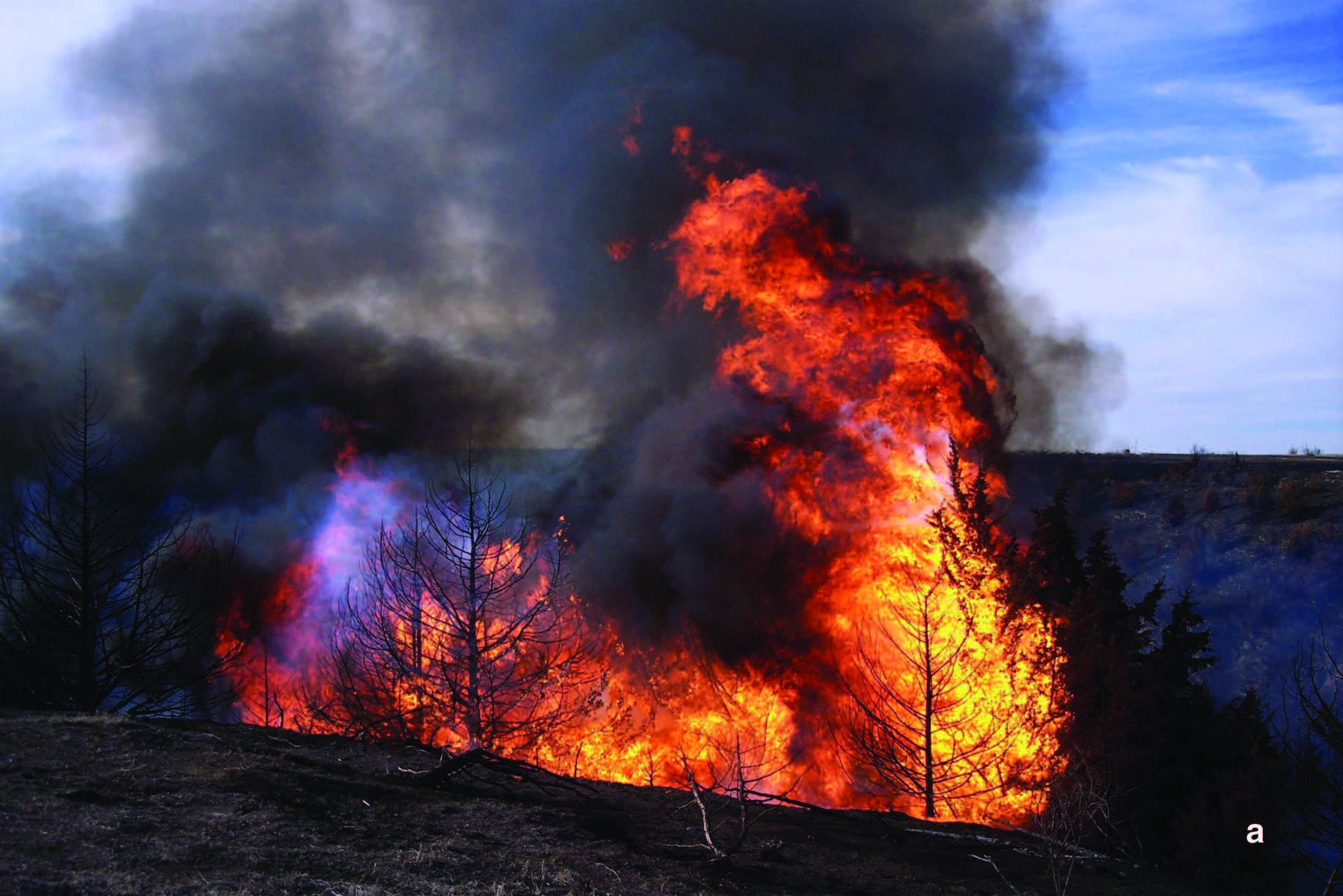

Figure 5. Photos showing the clear differences in fire intensity of (a) reactive fires versus (b) preventative fires for cedar tree control. (Photo [a] courtesy of Morgan Stout, Loess Canyon Rangeland Alliance; Photo [b] courtesy of Andy Moore)
Preventative management techniques possess an advantage over reactive techniques because the cedars being managed are much smaller, oftentimes shorter than the grass surrounding them. Targeting cedars at the seedling stage is key if managers are to be successful when applying the types of preventative techniques discussed in this publication.
The goal of preventative prescribed burning is to eliminate seedlings before they become a problem. Landowners should burn before cedar trees become visually obvious on the landscape. By using frequent prescribed burns in grasslands, it is easy to remove any establishing cedars before a mature stage is reached (Figure 5b). Low-intensity prescribed fires kill numerous seedlings that exist within the grass layer, which may not be visible before or after a fire is conducted. This prevents cedars from reaching heights that require high-intensity prescribed fires or more intensive mechanical removal.
On grasslands where topography permits, haying is one of the easiest techniques to prevent cedar invasion. With haying, small Eastern redcedar seedlings are removed (Figure 6). Removing seedlings by haying grasslands once every couple years is an effective proactive management technique because it prevents seedlings from reaching a size where haying is unable to remove them and more intensive techniques are required.
High-density goat grazing is another preventative Eastern redcedar management technique that is being used in the southern Great Plains. Goats now exist that have been bred to preferentially select cedar foliage over other browse (Taylor 2008). Land managers can utilize these “super juniper eating goats” and stock them at high densities in grasslands to consume small cedar seedlings and reduce competition with herbaceous plants (Allred et al. 2012) (Figure 7). These goats are not currently being used as a preventative technique in Nebraska, but we bring them up as an option because landowners are finding them to be helpful in preventing cedar invasions, and goat grazing is one of the only approaches that provides a market-based solution.
Preventative management techniques have their limitations. Haying is a limited technique in areas where terrain precludes access with equipment. High-density goat grazing also possesses limitations, including obtaining goats, special fencing requirements, and protecting goats from predators (Knezevic et al. 2005). In addition, lack of experience, equipment, fire policies, and narrow windows when burning is allowed may inhibit some land managers from implementing prescribed burns (Twidwell et al. 2013a).
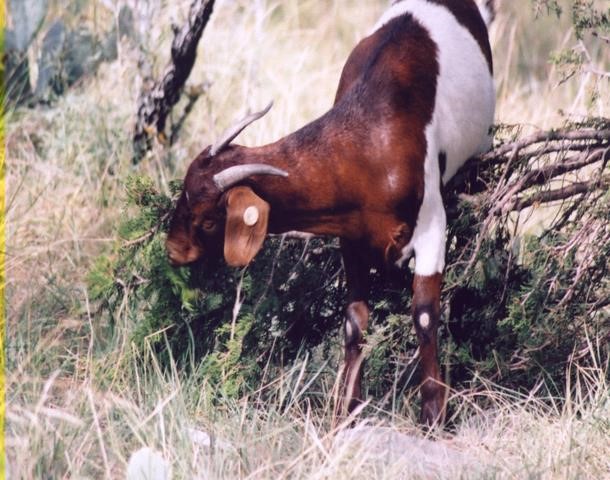
Figure 7. Juniper eating goats have been bred as a reaction to cedar invasion in southern Great Plains states, but they are more effectively used in preventative approaches. (Photo courtesy of Charles “Butch” Taylor)
Attempting to control and eradicate established invasive species populations is a difficult and costly battle (Olden et al. 2011). Many weedy species, including Eastern redcedar, experience a lag period between the time of their introduction and when they begin explosive growth. Land managers can limit introduced species from spreading and achieving large-scale invasions by taking advantage of that lag period and implementing preventative management techniques early on. That is why prevention is recognized as the cornerstone of invasive species management.
By waiting until cedars are readily visible, managers are reacting to cedar invasion, not preventing it. A general recommendation is that if you can see numerous seedlings above the grass layer, you already have a juniper problem. Currently, land managers in Nebraska have the opportunity to use preventative management strategies to reduce the intensity and more easily manage the invasion of Eastern redcedar (Olden et al. 2011; Hobbs and Humphries 1995).
In areas where cedars have invaded, hope is not lost. In many cases, using a single management technique is not effective; using a combination of complementary reactive and preventative management strategies is appropriate and effective. For example, an initial prescribed burn can increase the effectiveness and cost efficiency of other techniques by removing many smaller trees, which leaves fewer to treat with herbicides or mechanical removal (Ortmann et al. 1998).
In addition, cost-share dollars for mechanical treatment are increasingly being used to prep units for prescribed fire by cutting the required tree free zone around the unit and for “cutting and stuffing” trees on the interior of the unit to enhance mortality on the larger trees. By using a combination of treatments, more area can be treated than by using either reactive or proactive techniques in isolation. There is no evidence that reactive approaches, by themselves, can halt or reverse cedar invasions at a regional level. Instead, success with reactive management following cedar invasions has been realized on individual pastures or landholdings. For this reason, and given that reactive approaches are currently almost exclusively prioritized over proactive approaches in Nebraska, more consideration of how to prevent cedar invasions should be a greater priority of rangeland producers.
This article was written by students in the University of Nebraska–Lincoln course, AGRO 444—Ecosystem Monitoring and Assessment.
Allred, B.W., S.D. Fuhlendorf, F.E. Smeins, and C.A. Taylor. (2012) Herbivore species and grazing intensity regulate community composition and an encroaching woody plant in semi-arid rangeland. Basic and Applied Ecology 13:149–158.
Briggs, J.M., A.K. Knapp, J.M. Blair, J.L. Heisler, G.A. Hoch, M.S. Lett, and J.K. McCarran. (2005) An ecosystem in transition: Causes and consequences of the conversion of mesic grassland to shrubland. BioScience 55:243–254.
Engle, D.M., J.F. Stritzke, and P.L. Claypool. (1987) Herbage standing crop around Eastern redcedar trees. Journal of Range Management 40:237–239.
Engle, D.M., and J.D. Kulbeth. (1992) Growth dynamics of crowns of Eastern redcedar at 3 locations in Oklahoma. Journal of Range Management 45:301–305.
Fuhlendorf, S.D., S.A. Archer, F.E. Smeins, D.M. Engle, and C.A. Taylor Jr. (2008) The combined influence of grazing, fire, and herbaceous productivity on tree-grass interactions. Western North American Juniperus Communities. Springer New York, 219–238.
Hobbs, R.J., and S.E. Humphries. (1995) An integrated approach to the ecology and management of plant invasions. Conservation Biology 9:761–770.
Knezevic, S., S. Melvin, T. Gompert, and S. Gramlich. (2005) Integrated management of Eastern redcedar. University of Nebraska—Lincoln Extension EC186
Limb, R.F., D.M. Engle, A.L. Alford, and E.C. Hellgren. (2010) Tallgrass prairie plant community dynamics along a canopy cover gradient of Eastern redcedar (Juniperus virginiana L.). Rangeland Ecology and Management 63:638–644.
Olden, J.D., M.J. Vander Danden, and P.T.J. Johnson. (2011) Assessing ecosystem vulnerability to invasive rusty crayfish. Ecological Applications 21:2587–2599.
Ortmann, J., J. Stubbendieck, R.A. Masters, G.H. Pfeiffer, and T.B. Bragg. (1998) Efficacy and Costs of controlling Eastern redcedar. Journal of Range Management 51:158–163.
Ortmann, J., J. Stubbendieck, and R. Mitchell. (2007) Integrated management of Eastern redcedar on grasslands.
Owensby, C.E., K.R. Blan, B.J. Eaton, and O.G. Russ. (1973) Evaluation of Eastern redcedar infestations in the Northern Kansas Flint Hills. Journal of Range Management 26:256–260.
Pastro, L.A., C.R. Dickman, and M. Letnic. (2011) Burning for biodiversity or burning biodiversity? Prescribed burn vs. wildfire impacts on plants, lizard, and mammals. Ecological Applications 21:3238–3253.
Smith, S.D., and J. Stubbendieck. (1989) Chemical control of Eastern redcedar in mixed prairie. Proceedings of the North American Prairie Conference 11:147–150.
Smith, S.D., and J. Stubbendieck. (1990) Production of tall-grass prairie herbs below Eastern redcedar. Prairie Naturalist 22:13–18.
Taylor Jr., C.A. (2008) Ecological consequences of using prescribed fire and herbivory to manage Juniperus encroachment. In Western North American Juniperus Communities (pp. 239–252). Springer New York.
Twidwell, D., W.E. Rogers, S.D. Fuhlendorf, C.L. Wonkka, D.M. Engle, J.R. Weir, U.P. Kreuter, and C.A. Taylor. (2013a) The rising Great Plains fire campaign: citizens’ response to woody plant encroachment. Frontiers in Ecology and the Environment 11:64–71.
Twidwell, D., S.D. Fuhlendorf, C.A. Taylor, and W.E. Rogers. (2013b) Refining thresholds in coupled fire-vegetation models to improve management of encroaching woody plants in grasslands. Journal of Applied Ecology 50:603–613.